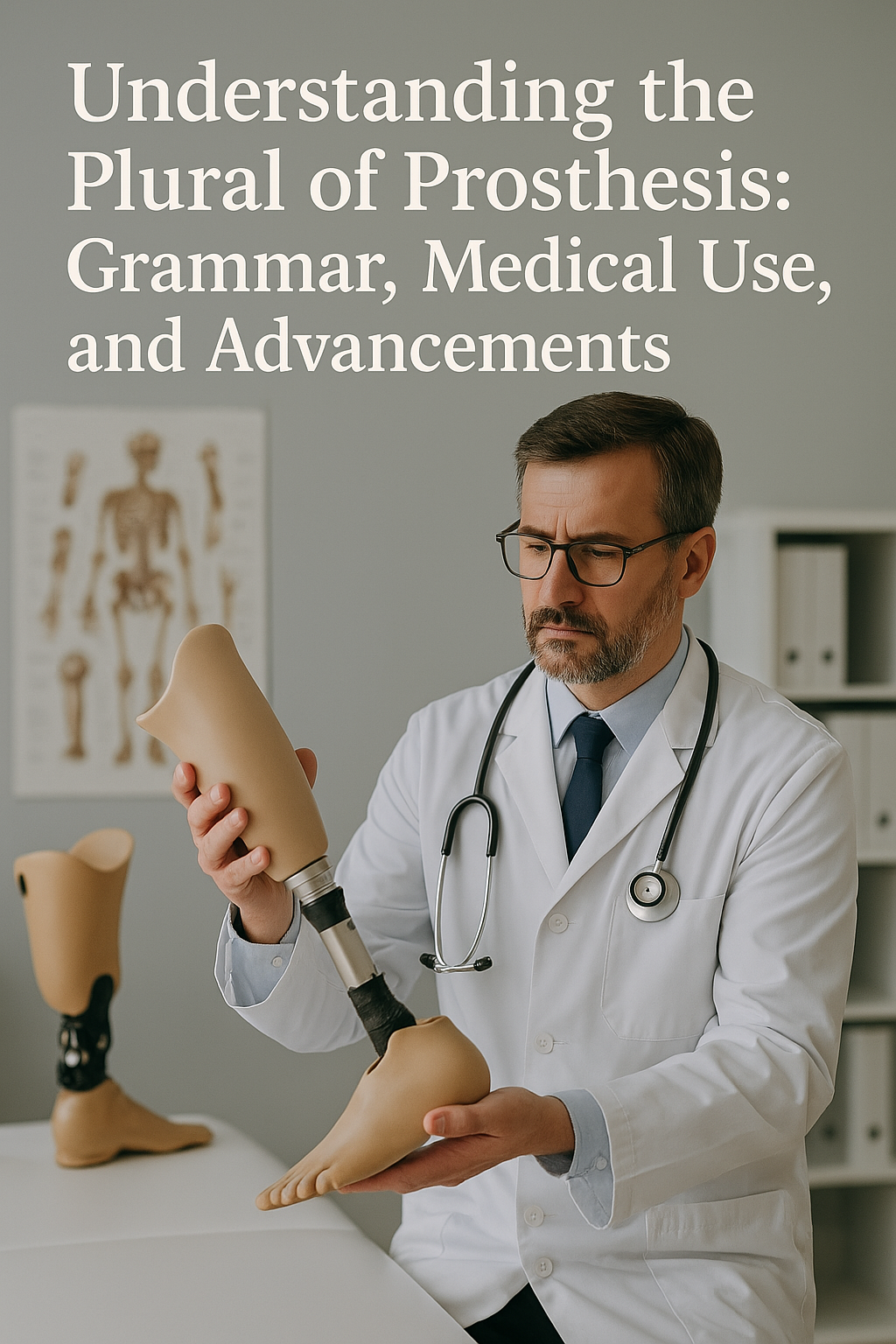Introduction
The English language can be tricky, especially when it borrows words from Greek and Latin. One such example is the word prosthesis. If you’ve ever wondered about the correct plural of prosthesis, you’re not alone. Many people struggle with its proper usage in both everyday conversation and medical settings.
This guide will cover everything you need to know about prosthesis plural forms, plural medical terms, prosthetic devices, and artificial replacements. We’ll also explore prosthetic technology, custom prostheses, and how these advancements are improving lives.
What Is the Plural of Prosthesis?
The plural of prosthesis is prostheses. Unlike regular English plurals that simply add an “s” or “es,” prosthesis follows Greek pluralization rules.
Why is it “Prostheses” and Not “Prosthesises”?
- Greek origin: “Prosthesis” comes from Greek, where words ending in “-is” often change to “-es” in the plural form.
- Examples of similar words:
- Thesis → Theses
- Crisis → Crises
- Analysis → Analyses
Using “prosthesises” would be grammatically incorrect. If you’re talking about more than one, always use prostheses.
Read More About This Article: The Past Tense of Meet: Picking the Right Verb
Prosthesis vs. Prostheses: Understanding the Difference
It’s easy to mix up singular and plural forms. Here’s how to use them correctly:
| Singular | Plural | Example Sentence |
|---|---|---|
| Prosthesis | Prostheses | The doctor fitted a prosthesis for her patient. |
| Advanced prostheses improve mobility for amputees. |
Common mistakes:
- Incorrect: He has two prosthesis.
- Correct: He has two prostheses.
How to Use Prostheses in a Sentence
- “Modern prostheses are more functional and comfortable than ever.”
- “The hospital specializes in prostheses for limb-loss patients.”
The Role of Prosthetic Devices and Artificial Body Parts
A prosthetic limb is a type of artificial body part designed to replace a missing limb. These devices improve mobility and restore functionality.
Types of Prosthetic Limbs
- Transradial – Replaces an arm below the elbow.
- Transfemoral – Replaces a leg above the knee.
- Bionic limb – Uses advanced sensors and robotics to mimic real movement.
- Mechanical limb – Basic movement through manual control.
Custom Prosthesis: Tailored Solutions for Individuals
Not all prosthetic devices are one-size-fits-all. Many require custom prosthesis designs to match a person’s unique body structure.
Benefits of Custom Prostheses
✔ Better Fit – Reduces discomfort and improves mobility. ✔ Increased Functionality – Designed to match the individual’s lifestyle. ✔ Aesthetic Appeal – Some people prefer prostheses that look more natural.
A personalized prosthetic can mean the difference between discomfort and a seamless, active life.
Advances in Prosthetic Technology
Thanks to modern innovations, prosthetic advancements are making artificial limbs more lifelike and functional.
Latest Developments in Prostheses
- Bionic limbs – Controlled by neural signals.
- 3D-printed prostheses – Affordable and customizable.
- Smart prosthetic devices – Can sense pressure and adjust movement.
- Limb replacement technology – Allows for more natural movement.
With these prosthesis advancements, people experiencing limb loss now have more options than ever before.
The Importance of Medical Language in Prosthetics
Understanding medical language is crucial when discussing prosthetic advancements. In healthcare, precise clinical language ensures that professionals communicate effectively.
Common Medical Terms Related to Prostheses
| Term | Meaning |
|---|---|
| Prosthesis | An artificial body part. |
| Prostheses | The plural form of prosthesis. |
| Bionic limb | A prosthetic limb with electronic components. |
| Artificial replacement | A general term for prosthetic devices. |
| Assistive device | Any tool that helps individuals with disabilities. |
How English Grammar Rules Apply to Medical Terms
English can be tricky, especially with pluralization rules. Here’s how to apply grammar rules to medical words:
Pluralization Patterns in Medical Terminology
| Singular | Plural | Example |
|---|---|---|
| Prosthesis | Prostheses | She has two prostheses after her surgery. |
| Diagnosis | Diagnoses | Multiple diagnoses were considered. |
| Bacterium | Bacteria | Harmful bacteria cause infections. |
Understanding linguistic rules like these ensures accurate usage in both speech and writing.
Case Study: The Impact of Prosthetic Advancements
To see the real-world impact of prosthetic technology, let’s look at the case of athlete Hugh Herr, a double amputee who revolutionized prosthetic advancements.
Key Takeaways from His Story
- Lost both legs in a climbing accident.
- Designed advanced bionic limbs that outperform traditional ones.
- Now leads MIT’s Biomechatronics Lab, developing next-gen prostheses.
His story highlights how technological progress in prosthetics is changing lives.
Conclusion: Why Understanding Prostheses Matters
Knowing the correct plural of prosthesis helps with grammar, while understanding prosthetic technology showcases how far science has come.
Key Takeaways
- “Prostheses” is the correct plural of “prosthesis”.
- Greek grammar rules influence medical terminology.
- Advances in prosthetic devices are improving quality of life.
- Custom prostheses provide better fit and function.
- Medical language ensures clear communication in healthcare.
As technology continues to evolve, so will our understanding of prosthetic advancements. Whether you’re a student, medical professional, or someone interested in artificial replacements, mastering these terms will enhance your knowledge and appreciation for this incredible field.
